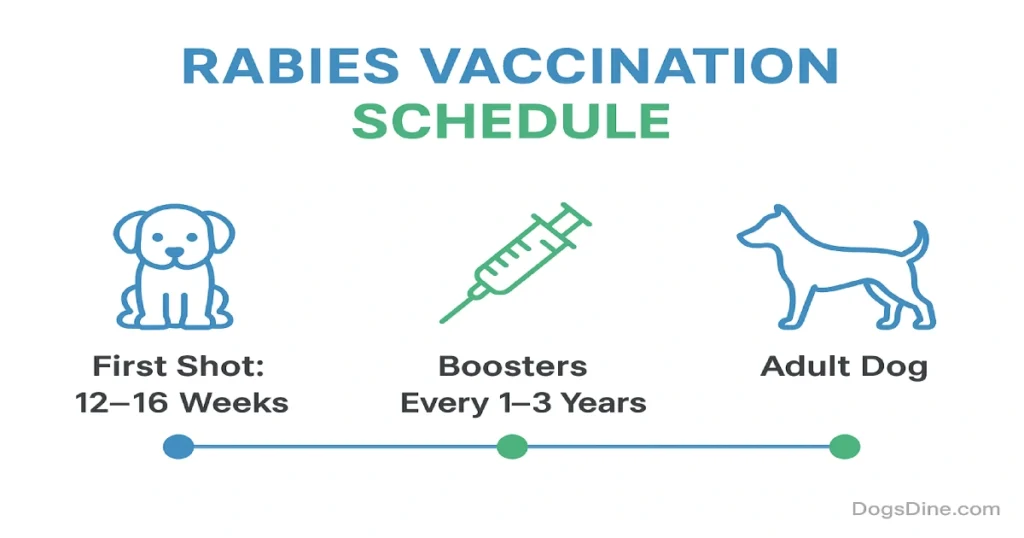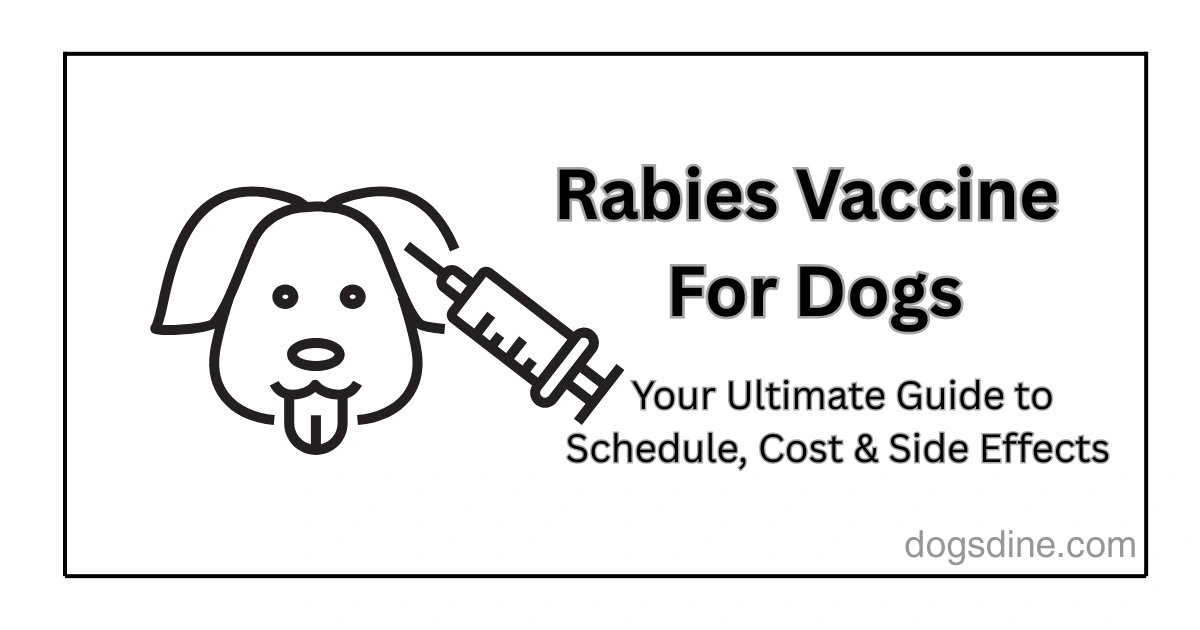Imagine your dog encountering a rabid raccoon during a walk without a rabies vaccine, the consequences could be deadly for your pet and even your family. Rabies is a fatal viral disease that spreads through bites, affecting dogs, humans, and wildlife. Fortunately, a simple rabies vaccine can protect your furry friend and keep your community safe.
In this comprehensive guide, we’ll cover everything you need to know about the rabies vaccine for dogs: schedules, costs ($15–$75), side effects, legal requirements, and expert tips to ensure your dog’s safety. Written with insights from Dr. Jane Smith, DVM, this article is your go-to resource for keeping your pet healthy in 2025.
What Is Rabies and Why Is It a Threat?
Rabies is a viral disease caused by the Lyssavirus, which attacks the central nervous system of mammals, including dogs and humans. According to the CDC, about 5,000 animal rabies cases are reported annually in the U.S., primarily in wildlife like bats, raccoons, and skunks. Once symptoms appear, rabies is almost always fatal, making prevention through vaccination critical.
How Rabies Spreads to Dogs and Humans
Rabies is transmitted through bites from infected animals, as the virus lives in their saliva. A dog bitten by a rabid bat or raccoon can contract the virus, which then spreads to the brain, causing severe symptoms. Humans can also get rabies from a dog bite, making it a zoonotic disease with serious public health implications.
Symptoms of Rabies in Dogs
Rabies symptoms in dogs vary but typically progress in two stages:
- Furious Stage: Aggression, foaming at the mouth, erratic behavior.
- Paralytic Stage: Weakness, paralysis, difficulty swallowing, death within 3–8 days.
Early signs include fever, anxiety, or hiding. If you notice these, contact your vet immediately.
Rabies in Wildlife: Risks from Bats, Raccoons, and Skunks
Wild animals are the primary carriers of rabies in the U.S. Bats are the leading cause of human rabies cases, while raccoons and skunks pose significant risks to dogs. Keeping your dog vaccinated and avoiding wildlife encounters is key to prevention.
Why Rabies Vaccination Is Essential for Dogs
The rabies vaccine is not just a choice—it’s a lifesaver and, in most states, a legal requirement. Here’s why it’s non-negotiable:
Protecting Your Dog’s Health
The rabies vaccine stimulates your dog’s immune system to produce antibodies against the virus, preventing infection even if exposed. Unvaccinated dogs face a near-100% mortality rate if infected.
Safeguarding Your Family and Community
Rabies is zoonotic, meaning it can spread to humans. Vaccinating your dog reduces the risk of transmission, protecting your family, neighbors, and other pets. In 2025, the CDC emphasizes vaccination as a cornerstone of rabies control.
Legal Requirements for Rabies Vaccines by State
Most U.S. states mandate rabies vaccination for dogs, with laws varying by region. Below is a table summarizing requirements in key states (based on AVMA data):
| State | Initial Vaccination | Booster Frequency | Penalty for Non-Compliance |
|---|---|---|---|
| California | 12 weeks | Every 3 years | Fines up to $1,000, quarantine |
| New York | 12 weeks | Every 1–3 years | Fines, possible euthanasia |
| Texas | 16 weeks | Every 3 years | Fines, impoundment |
| Florida | 12 weeks | Every 1 year | Fines up to $500 |
Source: AVMA Rabies Vaccination Laws, 2025
Check your local regulations to ensure compliance, as penalties can include fines, quarantine, or even euthanasia of unvaccinated dogs.
Rabies Vaccination Schedule for Dogs

A proper vaccination schedule ensures lifelong protection. Here’s what you need to know:
When to Vaccinate Puppies (12–16 Weeks)
Puppies typically receive their first rabies shot between 12 and 16 weeks of age. Dr. Stephanie Liff, DVM, recommends scheduling this with other core vaccines like DHPP to streamline care. Consult your vet for the best timing based on your puppy’s health.
1-Year vs. 3-Year Rabies Vaccines
There are two types of rabies vaccines:
- 1-Year Vaccine: Cheaper upfront ($15–$30), requires annual boosters.
- 3-Year Vaccine: Slightly pricier ($25–$50), but lasts longer, reducing vet visits.
Your vet will recommend the best option based on your dog’s lifestyle and state laws.
Booster Shots: How Often Are They Needed?
After the initial shot, boosters are required every 1–3 years, depending on the vaccine type and local regulations. Adventurous dogs in high-risk areas (e.g., rural regions with wildlife) may need annual boosters, while urban dogs may qualify for 3-year intervals.
How Much Does a Rabies Vaccine Cost?
Cost is a top concern for pet owners. Here’s a detailed breakdown:
Average Costs ($15–$75) and Regional Variations
In 2025, rabies shots typically cost $15–$75 per dose, depending on:
- Location: Urban clinics charge more ($40–$75) than rural ones ($15–$30).
- Clinic Type: Private vets are pricier than low-cost clinics or shelters.
- Vaccine Type: 3-year vaccines cost more than 1-year options.
Example Costs by Region (2025):
- California: $25–$50 (Contra Costa Animal Services: ~$20)
- New York: $40–$60 (Value Vet Hospital: $40)
- Washington: $50 (Good Neighbor Vet: $50 standalone)
Low-Cost Clinics and Vaccination Packages
Many animal shelters and mobile clinics offer rabies shots for $6–$20, often bundled with other vaccines. Check with local organizations like the ASPCA or Humane Society for affordable options.
Does Pet Insurance Cover Rabies Shots?
Some pet insurance plans cover rabies vaccines as part of wellness packages. For example, Lemonade’s preventative care plan may reimburse $15–$50 per shot. Review your policy or contact providers for details.
Rabies Vaccine Side Effects: What to Expect
While rabies vaccines are safe for most dogs, side effects can occur. Here’s what to watch for:
Common Side Effects (Lethargy, Soreness, Fever)
Most dogs experience mild reactions, including:
- Soreness at the injection site
- Lethargy or reduced appetite for 1–2 days
- Mild fever
These typically resolve within 48 hours. Offer extra water and rest to help your dog recover.
Rare but Serious Reactions (Anaphylaxis)
In rare cases (<1%), dogs may experience:
- Allergic reactions (hives, swelling)
- Anaphylaxis (difficulty breathing, collapse)
If you notice these, contact your vet immediately or visit an emergency clinic.
What to Do If Side Effects Occur
- Monitor your dog for 24–48 hours post-vaccination.
- Report severe symptoms to your vet.
- Keep vaccination records to track reactions for future doses.
Consequences of Skipping Rabies Vaccination
Skipping the rabies vaccine puts your dog and others at risk:
Risks of Rabies Exposure
Unvaccinated dogs exposed to rabies face:
- Near-100% mortality if infected.
- Transmission risk to humans or other pets.
- Quarantine periods (up to 6 months) at your expense.
Legal Penalties and Quarantine Rules
If your unvaccinated dog bites someone or is exposed to rabies, you may face:
- Fines ($500–$1,000, depending on state).
- Mandatory quarantine or euthanasia.
- Legal liability for medical costs if a human is bitten.
Tips to Protect Your Dog from Rabies
Beyond vaccination, take these steps to minimize risks:
Avoiding Wildlife Encounters
- Keep dogs leashed in areas with bats, raccoons, or skunks.
- Secure trash cans to deter wildlife.
- Avoid letting your dog roam unsupervised at night.
Regular Vet Checkups and Titer Testing
- Schedule annual vet visits to monitor vaccine status.
- Consider titer testing to check immunity levels before boosters, especially for older dogs.
Case Study: A Dog’s Close Call with Rabies
In 2024, a Texas dog named Max, unvaccinated due to his owner’s oversight, was bitten by a rabid skunk. Max faced a 6-month quarantine costing $2,000, and his owner paid a $500 fine for non-compliance. Fortunately, Max tested negative for rabies, but the ordeal could have been avoided with a $20 vaccine. This case underscores the importance of timely vaccination.
Faqs About Rabies Vaccines
How Often Do Dogs Need Rabies Shots?
Puppies get their first shot at 12–16 weeks, followed by boosters every 1–3 years, depending on the vaccine and state laws.
Can a Vaccinated Dog Get Rabies?
It’s extremely rare for a vaccinated dog to contract rabies, as vaccines provide near-100% protection if administered correctly.
Is the Rabies Vaccine Safe for Puppies?
Yes, the vaccine is safe for puppies over 12 weeks. Vets screen for health issues to minimize risks.
How Much Does a Rabies Shot Cost in My State?
Costs range from $15–$75, with low-cost clinics offering shots as low as $6. Check local shelters or vets for exact pricing.
What Happens If My Dog Bites Someone?
If unvaccinated, your dog may face quarantine or euthanasia, and you could face fines or liability. Vaccinated dogs typically undergo a 10-day observation period.
Conclusion: Keep Your Dog Safe with Rabies Vaccination
The rabies vaccine is a small investment ($15–$75) that delivers lifelong protection for your dog and peace of mind for you. By following the right schedule, understanding costs, and monitoring for side effects, you can keep your pet and community safe. Don’t wait schedule your dog’s rabies shot today!

